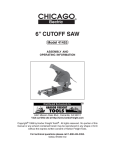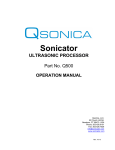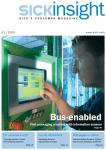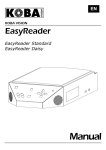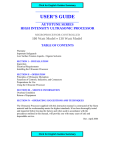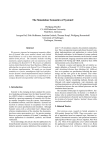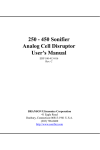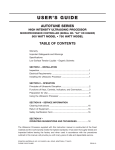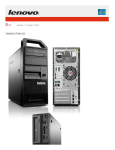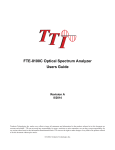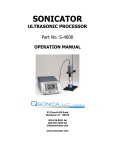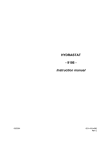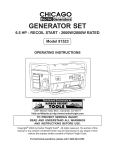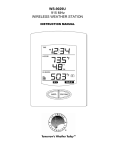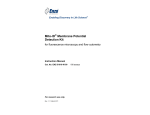Download Q700
Transcript
Sonicator ULTRASONIC PROCESSOR Part No. Q700 OPERATION MANUAL 53 Church Hill Road, Newtown, CT 06470 U.S.A Phone: 203.426.0101 · 1.877.338.9636 Fax: 203.426.7026 Web: www.sonicator.com · E-mail: [email protected] 1 Rev. 6-12 2 Rev. 6-12 Table of Contents Section Page No. 1. Warranty 4 2. Warnings 5 3. Specifications 6-7 4. Principles of Operation 8-9 5. Description of Components / Functions of Controls 10-12 6. Preparation for Use 13 7. Operating Instructions (Getting Started) 14-23 8. Maintenance 24-26 9. Troubleshooting 27 10. Service / Return of Equipment 28 11. Service Safety Certification form 29 3 Rev. 6-12 1. Warranty Your Ultrasonic Processor is w arranted and backed by the manufacturer for a period of tw o years from the date of shipment against defect s in material and w orkmanship under normal use as described in this instruction manual. During the w arranty period, the manufacturer w ill, at its option, as the exclusive remedy, either repair or replace w it hout charge for material and labor, the part(s) w hich prove to be defective, provided t he unit is returned to us properly packed w it h all transportation charges prepaid. Ultrasonic probes are guaranteed against defects for a period of one year from date of shipment. A defective probe w ill be replaced once w ithout charge, if failure occurs w ithin the w arranty period. Wear resulting from cavitation erosion is a normal consequence of ultrasonic processing, and is not covered by this w arranty. The manufacturer neither assumes nor authorizes any person to assume for it any other obligations or liability in connection w ith t he sale of its products. The manufacturer hereby disclaims any w arranty of either merchantability or fitness for a particular purpose. No person or company is authorized to change, modify, or amend the terms of this w arranty in any manner or fashion w hatsoever. Under no circumstances shall the manufacturer be liable to the purchaser or any other person for any incidental or consequential damages or loss of goodw ill, production, or profit resulting f rom any malfunction or failure of its product . This w arranty does not apply to equipment t hat has been subject to unauthorized repair, misuse, abuse, negligence or accident. Equipment w hich, show s evidence of having been used in violation of operating instructions, or w hich has had the serial number altered or removed, w ill be ineligible for service under this w arranty. All probes are manufact ured to exacting specifications and are tuned to vibrate at a specific frequency. Using an out -of-tune probe w ill cause damage to t he equipment and may result in w arranty nullification. The manuf acturer assumes no responsibility for probes fabricated by another party or for consequential damages resulting from their usage. The aforementioned provisions do not extend t he original w arranty period of any product that has either been repaired or replaced by the manufacturer. 4 Rev. 6-12 2. Warnings Please read the manual in its entirety. Necessary instruction and guidance are provided to help ensure the successful operation of this device. Your new Ultrasonic Liquid Processor has been designed, built and tested to assure maximum operator safety. How ever, no design can completely protect against improper use that may lead to bodily injury and/or property damage. For total safety and equipment protection, read the instruction manual carefully before attempting to operate this equipment. Observe the follow ing WARNINGS: High voltage is present in the generator (pow er supply), converter and high frequency cable. There are no user-serviceable parts inside any of these devices. Do NOT attempt to remov e the generator cover or converter case. Do NOT touch any open cable connections on the unit w hile the pow er is turned ON. Do NOT operate generator w ith converter disconnected from high voltage cable. High voltage is present in the cable and may pose a shock hazard. Do NOT attempt to disconnect the converter high voltage cable w hile the unit is running. The generator must be properly grounded w ith a 3 -prong plug. Test electrical outlet for proper grounding before plugging in unit. Install the ultrasonic processor in an area free from excessive dust, dirt, explosive or corrosive fumes and protected from extremes in temperature and humidity. Do not place the Generator w ithin a Fume Hood. Hearing protection is highly recommended. It is recommended that a sound abating enclosure or ear protection be used w hen operating the Ultrasonic Processor NEVER immerse the converter in liquids of any kind, or let condensed moisture or liquid drip into the converter. NEVER grasp an activated horn or probe. It can cause severe burns and tissue damage. NEVER allow a probe to vibrate in air. NEVER hold or clamp the converter by the front driver or by the horn itself. This can cause permanent damage to the system. Support the converter by only clamping around t he converter housing (upper portion). If needed air cool the convertor w ith dry compressed air. Do NOT allow the tip of a vibrating horn or probe to touch the counter top or any other hard surface. It could damage the probe, overload the generator, or damage the surface. Avoid touching the bottom or sides of a glass or plastic container w ith an activated probe. It could crack or shatter the glass or melt the plastic. Turn OFF the pow er sw itch, unplug the generator and disconnect the pow er cord from the back of the generator before attempting to replace the fuses. Inspect high frequency cable for cracks in the protective outer jacket. Do not operate unit w ith a damaged cable. Doing so may cause serious injury. In case of AC pow er loss, w ait 3 minutes minimum before reapplying pow er. Do not turn off AC mains pow er w hile running a horn. Stop sonication via touch screen prior to stopping pow er. 5 Rev. 6-12 Symbols Caution, Risk of electric shock, Hazardous voltage Caution, Risk of danger. Refer to User Manual. 6 Rev. 6-12 3. Specifications Generator Input Voltage 100 VAC – 120 VAC @ 50/60 Hz 220 VAC – 240 VAC @ 50/60 Hz 12 Amps max. 6 Amps max. 15 Amps* 8 Amps* Rated Current Fuse Rating Weight Dimensions 16 lbs. (7.3 Kg) 8" W x 15.25" L x 8.5" H 203 mm x 387 mm x 216 mm Output Voltage 1000 V rms (max.) Output Frequency 20 KHz Converter Weight Dimensions 2 lbs. (900 g) 7.25" L x 2.5" Dia. (183 mm x 63.5 mm) Materials Aluminum Alloy Standard ½ ” Horn Weight 0.75 lbs. (340 g) 5.375" L x .5" Dia. (136 mm x 13 mm) Dimensions Materials Titanium Alloy 7 Rev. 6-12 Environmental Pollution Degree 2 Installation Category II Operating Limits Temperature: 41 - 104ºF (5 - 40ºC) Relative Humidity 10 - 95% (Non Condensing) Altitude: 6,651 ft. (2000 m) Shipping/Storage Temperature: 35 -120 oF (2 - 49 oC) Relative Humidity 10 - 95% (Non Condensing) Ambient Pressure Extremes: 40,000 ft. (12,192 m) Restriction of Hazardous Substances (ROHS) Relative humidity Other Maximum relative humidity 80% for temperatures up to 31ºC decreasing linearly to 50% relative humidity to 40ºC For indoor use only * Only use IEC approved Fast acting fuses, Cooper Bussman series S500. The Power Cord supplied with the ultrasonic processor must be used. If the 220V plug is not configured to match the w all receptacle, a properly grounded universal AC socket adapter must be added. Important: Universal adapters do not convert voltage or frequency. The manuf acturer is not responsible for damage caused by the use of an improper pow er cord or adapter. Transformers are not recommended. WEEE Statement This product contains electrical or electronic materials. The presence of these materials may, if not disposed of properly, have potential adverse effects on the environment and human health. Presence of this label on the product means it should not be disposed of as unsorted waste and must be collected separately. As a consumer, you are responsible for ensuring that this product is disposed of properly. To find out how to properly dispose of this product contact Customer Service. 8 Rev. 6-12 4. Principles of Operation The ultrasonic electronic generator transforms AC line pow er to a 20 KHz signal that drives a piezoelectric converter/transducer. This electrical signal is converted by the transducer to a mechanical vibration due to the characteristics of the internal piezoelectric crystals. The vibration is amplified and transmitted dow n the length of the horn/probe w here the tip longitudinally expands and contracts. The distance the tip travels is dependent on the amplitude selected by the user through the touch screen pad. As you increase the amplitude setting the sonication intensity w ill increase w ithin your sample. In liquid, the rapid vibration of the tip causes cavitation, the formation and violent collapse of microscopic bubbles. The collapse of thousands of cavitation bubbles releases tremendous energy in the cavitation field. The erosion and shock effect of the collapse of the cavitation bubble is the primary mechanism of fluid processing. The probe tip diameter dictates the amount of sample that can be effectively processed. Smaller tip diameters (Microtip probes) deliver high intensity sonication but the energy is focused w ithin a small, concentrated area. Larger tip diameters can process larger volumes, but offer low er intensity. The choices of a generator and horns/probes are matched to the volume, viscosity and other parameters of the particular application. Horns are available for both direct and indirect sonication. The Accessories section has more information on this subject. Please consult w ith a product specialist for assistance w ith selecting a probe for your application. Relationship of Amplitude and Wattage Sonication pow er is measured in w atts. Amplitude is a measurement of the excursion of the tip of the probe (probe is also know n as a horn). Some ultrasonic processors have a w attage display. During operation, the w attage displayed is the energy required to drive the radiating face of a probe, at that specific amplitude setting against a specific load, at that particular moment. For example, the unit experiences a higher load w hen processing viscous samples then w hen compared to aqueous samples. The speed /cruise control on an automobile, can, to a certain extent, be compared to an Ultrasonic Processor. The speed/cruise control is designed to ensure that the vehicle maintains a constant rate of travel. As the terrain elevations change, so do the pow er requirements. The cruise control senses these requirements, and automatically adjusts the amount of pow er delivered by the engine in order to compensate for these ever changing conditions. The greater the terrain rate of incline and greater the resistance to the movement of the vehicle, the greater the amount of pow er that w ill be delivered by the engine to overcome that resistance and maintain a constant speed. The ultrasonic processor w as designed to deliver constant amplitude, to your liquid sample, regardless of these changes in load (much like the vehicle’ s cruise control described above). As a liquid is processed, the load on the probe w ill vary due to changes in the liquid sample (i.e. viscosity, concentration, temperature, etc.). As the resistance to the movement of the probe increases (increased load on the probe), additional pow er w ill be delivered by the pow er supply to ensure that the excursion at the probe tip remains constant. The displayed w attage readings w ill vary as the load changes, how ever the amplitude w ill remain the same. The resistance to the movement of the probe determines how much pow er w ill be delivered to 9 Rev. 6-12 maintain amplitude. For example, a ½ ” probe at 100% amplitude w ill require approximately 5 w atts to operate in air. The amplitude of this probe is approximately 120um. Insert the probe in w ater and the w attage reading w ill increase to approximately 90 w atts. The w attage required to operate the probe w ill increase as the load increases but the amplitude remains the same. The AMPLITUDE control allow s the ultrasonic vibrations at the probe tip to be set to any desired level. Although the degree of cavitation/ultrasonic energy required to process the sample can readily be determined by visual observation, the amount of pow er required cannot be predetermined. A sensing netw ork continuously monitors the output requirements, and automatically adjusts the pow er to maintain the amplitude at the preselected level. The greater the resistance to the movement of the probe due to higher viscosity, deeper immersion of the probe into the sample, larger probe diameter or higher pressure, the greater the amount of pow er that w ill be delivered to the probe. Sett ing the AMPLITUDE control to its maximum w ill not cause the maximum pow er rating of the unit to be delivered to the sample. The maximum pow er (700 w atts) that the Ultrasonic Processor is capable of delivering w ill only be delivered w hen the resistance to t he movement of the probe is high enough to draw maximum w attage. It is the intensity of cavitation that measures the effectiveness of the sonication, not the total pow er applied to the system. Intensity is directly related to the amplitude of the radiating face of the tip or horn. It is amplitude that must be provided, maintained, and monitored. The unit provides controlled amplitude under varying load conditions in order to give reproducible results. 10 Rev. 6-12 5. Description of Components / Functions of Controls The Model # Q700 includes a standard 1/2” diameter probe (#4220). 5a. Q700 Front Panel Converter Cable Converter Generator ½” Horn with replaceable tip 5b. Q700 Rear Panel On/Off Switch Cooling Fan Footswitch Jack Temperature Probe Connector Converter Cable Connector Fuses Power Cord Connector 11 Rev. 6-12 FUNCTIONS OF KEYS, CONTROLS, INDICATORS, AND CONNECTORS FRONT PANEL Touch screen display 0 – 9 key Displays prompts and control parameters including: • Amplitude selected • Output pow er delivered to the probe in w atts • Selected duration of processing • Actual processing time • Elapsed time • Set and read temperature • Pulse on/off duration • Accumulated amount of energy in Joules delivered to the probe Input digits for programming screens EXIT key Moves to previous screen ENT key Completes parameter entry on programming screens CLR key Deletes selected parameter entry RUN key To proceed to program run screen SAVE key Stores a program to the selected memory number. Up to 10 programs (0-9) can be stored. START/STOP key PAUSE key ▲ ▼ key Starts or stops the ultrasonics. Suspends operation, w ithout clearing program/run totals. Press pause again to resume program/run and continue accumulating run data. Used to set the amplitude of vibration at the probe tip. Also used to increase or decrease the amplitude in small increments w hile the unit is runnng. For explanations of each screen and button on the ultrasonic processor and complete programming instructions please see Section 7 of this manual. 12 Rev. 6-12 REAR PANEL On / Off Sw itch Footsw itch Connector Temperature Probe Connector Converter Cable Connector (Output) Pow er Supply Connector Turns the pow er supply on and off . Connects to the footsw itch cable. Connects to the Temperature monitoring probe or thermocouple Connects to the converter. Connects to the electrical line cord and encases the fuse(s). 13 Rev. 6-12 6. Preparation for Use INSPECTION Prior to installing the ultrasonic processor, perform a visual inspection to detect any evidence of damage, w hich might have occurred during shipment. Before disposing of any packaging material, check it carefully for small items. The ultrasonic processor w as carefully packed and thoroughly inspect ed before leaving our factory. The carrier, upon acceptance of t he shipment , assumed responsibility for its safe delivery. Claims f or loss or damage sustained in transit must be submitted to the carrier. If damage has occurred, contact your carrier w ithin 48 hours of the delivery date. DO NOT OPERATE DAMAGED EQUIPMENT. Retain all packing materials for future shipment. ELECTRICAL REQUIREMENTS The ultrasonic processor requires a fused, single phase 3-terminal grounding type electrical outlet. For pow er requirements, check the label on the back of the unit. WARNING For your personal safety, do not, under any circumstances, defeat the grounding feature of the power cord by removing the grounding prong. INSTALLING THE ULTRASONIC PROCESSOR The ultrasonic processor should be installed in an area that is free from excessive dust, dirt, explosive and corrosive fumes, and extremes of temperature and humidity. If processing flammable liquids, use an approved fume hood and do not place the pow er supply in the fume hood. When positioning the unit, be sure to leave adequate space behind the unit so that all connections can be easily disconnected. 14 Rev. 6-12 7. Operating Instructions (Getting Started) CAUTION Do not operate the pow er supply unless it is connected to the converter. Never allow liquid to spill into the converter. Do not allow a Microtip to vibrate in air. Do not allow the vibrating Microtip to contact anything but the sample. Never place a w asher betw een the converter, probe or horn. Never apply grease t o t he mat ing surfaces or t hreads of t he converter, probe or Microtip. Should it become necessary to remove a probe, use the w renches supplied. Never attempt to remove the probe by tw isting the converter housing or holding it in a vice, as this may damage the electrical connections w ithin the housing. CAUTION LOW SURFACE TENSION LIQUIDS – ORGANIC SOLVENTS The probes (solid or w ith a replaceable tip) are tuned elements that resonate at a specific frequency. If the replaceable tip is removed or isolated from the rest of the probe, the element w ill no longer resonate at that frequency, and the pow er supply w ill fail. Unlike aqueous (w ater based) solutions w hich rarely cause problems, solvents and low surface tension liquids are problematic. These liquids penetrate the probe/replaceable tip interface, and force the particulates into the threaded section isolating the tip from the probe. When processing low surface tension liquids, ALWAYS use a solid probe. Set-up: 1. Connect t he pow er cord into the receptacle on the rear of the ultrasonic processor. 2. Make sure the unit is sw itched off. Plug the electrical line cord into t he electrical outlet. 3. If the optional foot sw itch is used, insert t he plug int o the jack located on the rear panel. 4. For best results it is crit ical to use t he appropriate size and type of accessory to process your sample. If you are not sure that you have the proper horn for your sample volume please refer to the Accessories section of this manual or call the manufacturer for assistance. 5. Horns/Probes must be properly tightened. Depending on the accessories purchased, often the horn and the flat tip are attached to the converter at the fact ory. Check the tightness of the horn and flat tip by using the wrench set. Please ref er to images in the Maintenance section of this manual. A loose horn or tip may cause damage to the generator circuitry or parts of the converter and horn. A loose horn may also show a 15 Rev. 6-12 fluctuation in w attage readings. Always use the wrenches supplied with the unit. 6. If you w ill be using a Microtip or extender, remove the flat tip on the end of the replaceable tip probe, t hen attached the Microtip or extender in its place. 7. Horns and probe tips w ear after normal usage. Using a severely w orn probe tip can damage internal generat or components. 8. If using a laboratory stand, mount the convertor /probe assembly using a clamp. Be sure to secure the clamp to the upper section of the convertor housing only. Never secure the clamp to any other portion of t he convertor/probe assembly. If you are using an acoustic enclosure mount the convertor properly in the convertor collar. 9. Connect t he converter cable to the pow er supply and then to the top of the convertor. Push the connectors in and turn the chrome rings clockwise ¼ turn to secure the connectors. 10. If application or procedure instructs that t he unit be run for a period of time that w ill allow the probe/convert or assembly to be w arm to t he touch, it is recommended that the convertor be air cooled w ith dry compressed air. Never run the convertor and horn assembly if it becomes hot. Connect either one of the air fittings on top of the converter to a source of dry compressed air. This will cool the convertor so that it can function normally under load for an extended duration without becoming too hot. Operation: Your new ultrasonic processor has been designed w ith a color LCD user interface w it h touch screen capabilities. All program and run functions are controlled through the touch screen panel. This is the first screen t hat appears aft er Ultrasonic processor is sw itched On. 1. Answ er the Microtip Question, Yes or No. When using a Microtip, the YES button must be selected. 16 Rev. 6-12 * If you are not familiar w ith t he microtips and need assistance, please call your representative for help. Warning: Improper selection may result in tip damage or poor sonication. Damage caused by not f ollow ing t his step is not covered under the w arranty. After answ ering t he Microtip question, the follow ing screen appears: To Manual Mode To Program Menu To Option Screen To Previous Screen This screen allow s the user to select Manual mode, Program menu or Options screen. 2. Select the Mode of Operation or access Options screen. a. Manual Mode: Selecting Manual Run allow s the user to set the unit output level manually (setting 1 – 100% ). Starting and stopping t he ultrasound output is also manually performed. b. Program Mode: Allow s the user to create a program w ith specific On / Off times and output setting. The ability to save up to 10 programs and sequence several individual programs toget her can also be perf ormed in this mode. c. Options: Allow s the user to change display contrast, and select either ºC or ºF if temperature monit oring is enabled. Footsw itch and temperature probes are optional items and are not shipped unless specifically ordered w ith the unit. 17 Rev. 6-12 The follow ing screen displays the Manual Mode. A B E C F D G A. Microtip Mode – Indicates that the unit is set for use w ith microtips only. This mode should not be used w it h standard probes or horns (1/2” or larger). See page 15 for information on selecting YES or NO at the “ Are you using a M icrotip screen” . B. Amplitude (intensity) setting - Output amplitude may be set betw een 1 -100% . C. Pow er displayed in Watts. D. Energy displayed in Joules. E. Elapsed Time – Total time of active sonication. F. Temperature probe measurement (note: if “ OPN” appears, it indicates temperature monitoring has been activated but the probe is not connected). G. Temperature probe On/Off indicator. Touch the box to activate temperature monitoring. A check mark w ill appear indicating that temperature monitoring is activated. Select the appropriate Amplitude (intensity setting) for your sample by touching t he Up or Dow n arrow . Touch St art to begin sonication. Touch Pause to pause sonication. Manual and Program modes bot h show the Start, Pause and Exit buttons. After touching the Start button and activating sonication, the Start button becomes a Stop button. After touching the Pause button, the Pause button becomes the Resume butt on. If sonication is stopped, Energy and Elapsed Time values remain on display. If the Start button is t ouched again, the values are reset. If sonication is Paused and Resumed, the Energy and Elapsed time data w ill resume counting from the point at w hich it w as paused. The Temperature Probe option can be selected if you w ish to monitor t he temperat ure of the sample being processed. 18 Rev. 6-12 Program Menu The unit can be programmed to sonicate at specific, user-selected time intervals including pulse mode. To Sequence 1 Screen To Program Screen To Option Screen To Sequence 2 Screen To Previous Screen Select/Modify a Program – Create, select or modify up to 10 different programs. Select/Modify Sequence 1 & 2 – Select a sequence of programs for the unit to run in succession. A maximum of 6 programs can be sequenced at one time. Option Screen - The Option menu enables the selection of Temperature units, Footsw itch operational mode and Display contrast. 19 Rev. 6-12 Programming Screen How To Create a Program The ultrasonic processor has the ability to save up to 10 programs. 1. Select a program number from the keypad, the program number w ill appear above the Amplitude box. For each of the following steps: After touching a field, the background w ill change to yellow indicating an active field. After entering data, the ent ry is completed by touching Enter (ENT), touching the field a second time or by touching a new field. 2. 3. 4. Program a value into the Amplitude field. Program total Process Time (total active sonication time). Program Pulse On time – If no data is entered (00hr:00min:00sec), the unit w ill run continuously w ithout pulsing. 5. Program Pulse Off time – If no data is entered, the unit w ill run continuously w ithout pulsing. Process Time, Pulse On and Pulse Off times are measured in Hours: Minutes: Seconds format. 6. 7. Activate Temperature Monitoring (if necessary). Program a Shutdow n Temperature (if necessary). Enter a temperature value. During sonication, if the temperature reaches the Shutdow n value, the unit w ill pause sonication. The unit w ill remain paused until the temperature drops below the pre-set value. Once the temperature drops below the value, sonication can be manually resumed. 8. Touch Save to store the program to the memory number selected in step 1. 9. Touch Run to proceed to the follow ing screen. Total programmed time of active sonication. Rest or Off time is not included in this value. Total time of active sonication that has occurred during the current program. Rest or Off time is not included in this value. Program Progress 10. Touch Start to begin the program. 20 Rev. 6-12 How To Run A Saved Program From the program screen (see image at top of previous page), touch the program number on the right side of the screen and t he selected program settings w ill appear. Follow steps 9 and 10 from the previous page. This Run screen is an example of a sample program in progress. Total programmed time of active sonication. Rest or Off time is not included in this value. Total time of active sonication that has occurred during the current program. Rest or Off time is not included in this value. Program Progress The Temperature Monitoring and Shutdow n Temperature option hav e been selected during this example program. Program Progress is displayed by a bar graph. This displays the progress of the current program including both the On and Off time combined. 21 Rev. 6-12 Sequencing After selecting Sequence 1 or 2 from the Program Menu, the follow ing screen w ill appear: Sequence Programming Screen Program Number Selected Delay Field After creating multiple programs, a sequence of those programs may be selected. Select the Program Number and the amount of time desired betw een Programs. Save the settings and touch Run to begin the sequence of programs. How to Create a Sequence 1. 2. 3. Touch the Program (PGM) field, select the appropriate program number and touch ENT. Enter each desired program number in order, in the PGM fields. If a delay or rest time betw een programs is desired, touch the Delay After field. Enter the appropriate time frame. 4. Unused PGM fields should have a dash (-). Select unsused programs, touch CLR and ENT if necessary. 5. The last Delay After field as w ell as any unused fields should be cleared to 00:00:00 as displayed in NUM 3, PGM 2 as show n above. Select unsused fields, touch CLR and ENT if necessary. 6. Touch Save to store the sequence. How to Run a Sequence From the Sequence Program Screen, touch Run, the follow ing screen w ill appear: 22 Rev. 6-12 Sequence Progress Bar – The measure of the total of all programs in the sequence including On, Off and Delay After times. The follow ing Option Screen can be accessed from either Menu Screen. The Option menu enables the selection of Temperature units and Footswitch operational mode. Option Screen Temperature Units – A temperature probe (Part# 4102 or 4103) is required for use of this option. The Temperature Probe option can be selected if you w ish to monitor t he temperat ure of the sample being processed. The temperature probe must be plugged into the back of the ultrasonic processor and the probe tip must be in t he liquid sample. If the initial sample temperature is above the set point, sonication w ill not turn on. During sonication, if the temperature reaches the Shutdow n value, t he unit w ill pause sonication. The unit w ill remain paused until the temperature drops below the pre-set temperat ure limit , at w hich time sonication can be manually resumed. Footswitch Operation – A footsw itch (# FS-3) is required for use of t his option. After setting up a program, the footsw itch can be used to remotely activate the unit. Exit – The Exit button w ill save changes and return to the previous screen. 23 Rev. 6-12 Techniques for Optimizing Results Probe Depth Immerse t he probe tip 1.5 times the tip diameter into t he solution, w ithout touching the bottom. For example, t he ½ ” horn should be immersed ¾ ” below the liquid surface. Immersion depth can be less for larger horns and may have to be more for smaller probes used at higher intensity. Foaming and Aerosoling Aerosoling and foaming generally occur w hen t he tip is not immersed f ar enough into the solution. Low ering the t ip in the solution, decreasing pow er, and reducing solution temperature w ill normally prevent foaming. Low ering the pow er and increasing sonication time w ill usually reduce aerosoling; in severe cases, use an aerosol cap or sealed atmosphere treat ment chamber. In organic materials, protein release f rom cell material acts like a w etting agent and tends to promote foaming. For severe foaming: Use a narrow er processing vessel Use a vessel w ith an irregular inner surface Increase effective viscosity by concentration or by adding glass beads. Once foaming occurs, shut off pow er or reduce it below cavitation level before proceeding. It may be necessary to use a centrifuge or high vacuum to reduce tenacious foam. If foam persists, the sample may have to be discarded. If f oaming continues t o be a problem, an indirect sonication device (such as a Cup Horn) may be a better option. Viscosity Limitations Viscous solutions and highly concentrated liquids can be difficult t o sonicate. If the liquid is so thick that it w ill not pour or circulate easily it is too thick and cannot be processed effectively. Keeping Samples Cool Intense ultrasonic processing causes the liquid temperature to elevate especially w ith small volumes. High temperat ures reduce cavitation so the liquid should be kept as cold as possible. This can be accomplished by immersing the sample vessel in an ice-salt-w ateralcohol bath, or by using a w ater-jacketed processing vessel w ith cold w ater circulation. To minimize temperature elevation, use a pulse mode. Free Radical Information Trace free radicals produced by ultrasonics w ill usually have little or no enzyme activity. The free radicals may be H2 O2 , O3 as w ell as many other molecules and ions produced from air or w ater. If this kind of reaction is suspect ed, it can easily be avoided by using CO 2 or N2 atmosphere. A CO2 atmosphere is quickly obtained by placing a pellet of dry ice in the solution before processing and let it " bubble out" . A CO2 atmosphere stops luminescence in the cavitation bubble for the same reason it prevents it in a vacuum tube. It is this luminescence w hich causes the w ater and air molecules to break up producing the radicals. This CO2 procedure, as simple as it is, again is ordinarily unnecessary. 24 Rev. 6-12 9. Maintenance It is recommended t o periodically inspect t he unit, both visually and physically, to insure optimum and safe performance. This inspection should be scheduled as a routine maintenance procedure, done w ith the unit pow er OFF and w ith the unit unplugged from the AC pow er source. Long exposure t o acids or caustics results in corrosion of metal parts or components. Check the generat or, converter, and cables periodically for any signs of rust or discoloration. If discoloration is found, move the ultrasonic processor aw ay from the source of the contaminant. Examine the condition of the high voltage cable that attaches the converter to the generator. Inspect the w ire insulation for damage, such as w ear, burning from hot plate contact or breakage from extended use or rough handling. In general use, the cable assembly should not be used to carry the converter or pull it tow ard the user. Make certain the cable alw ays has slack and is never tensioned. If necessary, move the generator or converter assembly closer to one another to accomplish this. If this is not possible, contact your Customer Service Representative to obtain a longer cable. WARNING: Do not use a cable with broken end connections, exposed wires or frayed insulation. High voltage is present in the cable and will pose a shock hazard. Do not touch the converter assembly until the power switch is off and the unit is unplugged. Microtip/ Probe Maintenance Ultrasonic processors create high intensity vibration w hich puts stress on the converter and horn assembly. The sides and end of the probe must never be allow ed to come in contact w ith anything but the solution. When using a Microtip, the stress resulting at t he point of contact w ith the vessel could cause the Microt ip to fracture. Proper care of the probe is essential for dependable operation. The intense cavitation w ill, after usage for period of time, cause the tip to erode, and the pow er output to decrease. The smoother and shinier the tip, the more pow er w ill be t ransmitted into the sample. The vibrations may also cause the probe tip to loosen over time or the t hreaded connection to accumulate debris. Note: A loose probe w ill usually generate a loud piercing or squealing sound. For that reason, it is recommended that a preventative maintenance schedule be adopted to examine the unit at regular intervals. The schedule should depend on frequency of use. Weekly maintenance schedules are recommended for units used frequently or monthly for those used infrequently. The tip must be examined for excessive w ear and to ensure that the threaded connection is clean and attached properly t o the convert or. Use a cotton sw ab and alcohol (i.e. ethanol, isopropyl, etc.) to clean the threaded mating surfaces. When excessive wear (corrosion/pitting of the probe tip) is detected the probe should be replaced with a new one. WARNING: Never hand tighten probes or horns onto the convertor; properly tighten them with the appropriate Wrench Set. Steps for att aching and detaching microtip probes: 25 Rev. 6-12 Follow the steps below for attaching and detaching accessories: 1. Disconnect probe from convertor. Use t he w rench set provided w ith the system. 2. Clean t hreaded stud. Use alcohol and a cotton sw ab to remove any debris on the threading of the connecting stud. Allow the alcohol t o dry completely. 3. Clean threading in converter. Hold the convertor horizontally and use alcohol and a cotton sw ab to remove any debris on t he threading. Do not allow liquid to drip into Convertor. Allow the alcohol t o dry completely. 4. Reattach probe to convertor. Screw the probe back ont o the convertor and tighten w ith the w rench set provided. 5. The tips on replaceable tip probes can be removed for cleaning and/or replacement. When replacing horns or horn tips, Alw ays clean the threaded mating surfaces of the convertor and horn. Use alcohol and a cotton sw ab to remove any debris on the threading of the tip or probe. Note: If the replaceable tip loosens during sonication, be sure to remove the tip f or cleaning and inspect the threading on t he tip and probe. Call 26 Rev. 6-12 the manufacturer for assistance if the threading is chipped or damaged in anyw ay. Replacement Tip Removal Replacement Tip Tightening Replacement Tip Removal Replacement Tip Tightening * Note: When tightening a Microtip the tip must not be in contact w ith the w ork surface. Alw ays have the tip ext ending off of the table or w ork surface to minimize stress to the tip. System Cleaning Instructions The generator and converter may be cleaned using an acid-free cleaning solution (i.e. glass cleaner). Probes should be cleaned using isopropyl alcohol. Probes are made from titanium and can be autoclaved (the converter is an electrical part and cannot be sterilized in this manner). Before each procedure place the probe tip in w ater or alcohol and turn the pow er on for a few seconds t o remove residue. The tip also can be sterilized using alcohol w ith t he pow er on. 27 Rev. 6-12 9. Troubleshooting Your Ultrasonic Processor w as designed to provide you w ith years of safe and dependable service. Nevertheless, because of component f ailure or improper usage, the possibility does exist that it might not perform as it should, shut dow n or stop w orking all together. The most probable causes f or malfunction are listed below and should be investigated. A connector or cable is damaged. The unit w as plugged into an electrical outlet t hat provides a different voltage from that required. See Elect rical Requirements. The horn, probe, boost er or microtip is not tightened properly w ith the w renches provided. The convertor and/or microtip has been dropped. A microtip being operat ed is damaged or w orn past its useful life. A fuse(s) has failed. OVERLOAD CONDITION If the Ultrasonic Processor stops w orking, and an OVERLOAD indication is displayed on the screen, check for possible causes as outlined in the above paragraph. Then press the OFF key to sw itch the unit off, and the ON key to sw itch the unit back on t o restart the equipment. If the problem persists after inspecting all of these, please contact Customer Service for additional assistance or to replace a worn microtip or damaged part. Note: Most faults can be solved by cleaning all mating and threaded surfaces using isopropyl alcohol and properly re-assembling tightly together using the appropriate w renches. Note: If t he display freezes, sw itch Off main pow er, w ait 5 seconds and sw itch back On. Note: If you touch Start and sonication does not occur, sw itch Off main pow er, w ait 5 seconds and sw itch back On. If these steps do not solve your problem, please contact a Customer Service Representative. 28 Rev. 6-12 10. Return of Equipment It is suggested that an Ultrasonic Processor in need of repair be sent back to the factory. In order t o receive prompt service; alw ays cont act your Customer Service Representative before returning any instrument. Include date of purchase, model number and serial number. Please obtain a Return Authorization Number prior to returning the instrument. Care should be exercised to provide adequate packing to insure against possible damage in shipment. The Ultrasonic Processor should be sent to the “ Service Department” w ith all transportation charges prepaid and return of shipment indicated. Important The user must certify that the ultrasonic processor and/or the accessories returned for repair are free of any biohazardous or radioactive material and are safe for handling. Please complete the “ Safety Certification” form on t he next page and send it in w ith your equipment. Do not return any equipment unless such a certification can be made. 29 Rev. 6-12 SAFETY CERTIFICATION FORM Items being returned: ______________________________________________________________________________ ______________________________________________________________________________ ______________________________________________________________________________ ______________________________________________________________________________ ____________________________________________________________________ Please check only one item below : ___ The equipment w as never used or exposed to any radiological, biological or chemical agents and is safe to handle, use or dispose of. ___ The equipment w as used but not in conjunction w ith or exposed to any radiological, geological or chemical agents and is safe to handle, use, or dispose of. ___The equipment w as used in conjunction w ith or exposed to radiological, biological, or chemical agents and has been decont aminated, rendering it saf er for handling, use, or disposal. Authorization By accepting authorization to return the equipment listed above, the undersigned assumes all responsibility and liability for radiological, biological and chemical decont amination. Delivery of the equipment can be refused if necessary documentation is not provided or w here it is determined that the equipment has not been properly decont aminated. If it is determined that the equipment w as not properly decontaminated, the Authorized Repair Facilit y reserves the right to bill the customer for any and all costs associat ed w ith the decontamination and/or appropriat e disposal of the equipment. In the event the equipment has been exposed to radiological cont amination, the signature of the Radioactive Safety Officer is required. Print name: ___________________________________ RA # ___________________ Signature: ____________________________________ Date: __________________ 30 Rev. 6-12































